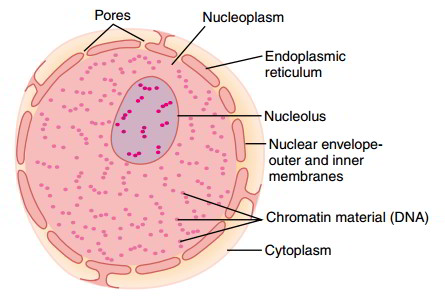Nucleus is the most popular and the biggest cellular organelle. It has a size of 10 g to 22 g and inhabits about 10% of overall volume of the cell.
Nucleus exists in all the cells in the body other than the red blood cells The cells with nucleus are called eukaryotes and those without nucleus are called prokaryotes Existence of nucleus is required for cellular division.
The majority of the cells have just one nucleus (uninucleated cells) Some types of cells like skeletal muscle cells have numerous nuclei (multinucleated cells). Typically, the nucleus lies in the centre of the cell. It is primarily round fit. Nevertheless, the shape and scenario of nucleus differ in some cells.
Structure of Nucleus
Nucleus is covered by a membrane called nuclear membrane and includes numerous components Significant components of nucleus are nucleoplasm, chromatin and nucleolus.
Nuclear Membrane
Nuclear membrane is double layered and permeable in nature. This permits the nucleoplasm to interact with the cytoplasm. The external layer of nuclear membrane is constant with the membrane of endoplasmic reticulum. The space in between the 2 layers of nuclear membrane is constant with the lumen of endoplasmic reticulum.
Pores of the nuclear membrane are safeguarded (lined) by protein molecules Size of the pores has to do with 80 to 100 nm. Nevertheless, it is reduced to about 7 to 9 nm since of the accessory of protein molecules with the periphery of the pores. Exchange of products in between nucleoplasm and cytoplasm happens through these pores.
Nucleoplasm
Nucleoplasm is an extremely thick fluid that forms the ground substance of the nucleus It resembles cytoplasm present outside the nucleus.
Nucleoplasm surrounds chromatin and nucleolus. It includes thick fibrillar network of proteins called the nuclear matrix and numerous substances such as nucleotides and enzymes. The nuclear matrix forms the structural structure for arranging chromatin. The soluble liquid part of nucleoplasm is called nuclear hyaloplasm.
Chromatin
Chromatin is a thread-like product comprised of big molecules of DNA. The DNA molecules are compactly loaded with the assistance of a specialized standard protein called histone. So, chromatin is referred as DNA-histonecomplex It forms the significant bulk of nuclear product.
DNA is a double helix which twists around central core of 8 histone molecules to form the essential packaging unit of chromatin called nucleosome. Nucleosomes are compacted securely with the assistance of a histone molecule to form a chromatin fiber.
Prior to cell division, the chromatin condenses to form chromosome.
Chromosomes
Chromosome is the rod-shaped nuclear structure that brings a total plan of all the genetic characteristics of that types. A chromosome is formed from a single DNA molecule coiled around histone molecules Each DNA includes numerous genes.
Generally, the chromosomes are not noticeable in the nucleus under microscope Just throughout cell division, the chromosomes show up under microscopes This is since DNA ends up being more securely loaded prior to cellular division, makings the chromosome noticeable throughout cell division.
All the dividing cells of the body other than reproductive cells consist of 23 sets of chromosomes. Each set includes one chromosome acquired from mother and one from father The cells with 23 sets of chromosomes are called diploid cells The reproductive cells called gametes or sex cells consist of just 23 single chromosomes. These cells are called haploid cells.
Nucleolus
Nucleolus is a little, round granular structure of the nucleus Each nucleus includes several nucleoli. The nucleolus includes RNA and some proteins, which resemble those discovered in ribosomes. The RNA is manufactured by 5 various sets of chromosomes and kept in the nucleolus. Later on, it is condensed to form the subunits of ribosomes. All the subunits formed in the nucleolus are transferred to cytoplasm through the pores of nuclear membrane. In the cytoplasm, these subunits fuse to form ribosomes, which play an important role in the formation of proteins.
Functions of Nucleus
Significant functions of nucleus are the control of cellular activities and storage of genetic product. A number of processes are associated with the nuclear functions Functions of nucleus:
- Control of all the cell activities that consist of metabolism, protein synthesis, growth and reproduction (cellular division)
- Synthesis of RNA
- Formation of subunits of ribosomes
- Sending out genetic guideline to the cytoplasm for protein synthesis through messenger RNA (mRNA) Control of the cell division through genes
- Storage of genetic info (in genes) and improvement of this info from one generation of the types to the next.


 (66 votes, average: 4.11 out of 5)
(66 votes, average: 4.11 out of 5)